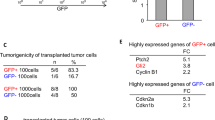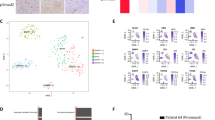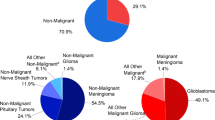Abstract
Hedgehog pathway activity has been demonstrated in malignant glioma. However, its role in tumor growth has not been determined. Here we demonstrate that pharmacological inhibition of the Hedgehog pathway in established orthotopic malignant glioma xenografts confers a survival advantage. Pathway inhibition is measured in transplanted human tumor cells and not in host mouse brain. Correspondingly, survival benefit is observed only in tumors with an operational Hedgehog pathway. These data indicate that Hedgehog signaling regulates the growth of select malignant gliomas. We also demonstrate that Hedgehog pathway component and gene target expression segregate to CD133+ tumor initiating cells. Treated mice eventually succumb to disease, thus, targeting the Hedgehog pathway in CD133+ cells produces significant, but incomplete tumor regression. Therefore, our studies suggest that more complete tumor regression may require the inclusion of other therapeutic targets, including CD133− cells.
This is a preview of subscription content, access via your institution
Access options
Subscribe to this journal
Receive 50 print issues and online access
$259.00 per year
only $5.18 per issue
Buy this article
- Purchase on Springer Link
- Instant access to full article PDF
Prices may be subject to local taxes which are calculated during checkout




Similar content being viewed by others
References
Ahn S, Joyner AL . (2005). in vivo analysis of quiescent adult neural stem cells responding to Sonic hedgehog. Nature 437: 894–897.
Bao S, Wu Q, McLendon RE, Hao Y, Shi Q, Hjelmeland AB et al. (2006). Glioma stem cells promote radioresistance by preferential activation of the DNA damage response. Nature 444: 756–760.
Bar EE, Chaudhry A, Lin A, Fan X, Schreck K, Matsui W et al. (2007). Cyclopamine-mediated hedgehog pathway inhibition depletes stem-like cancer cells in glioblastoma. Stem Cells 25: 2524–2533.
Barker N, Ridgway RA, van Es JH, van de Wetering M, Begthel H, van den Born M et al. (2009). Crypt stem cells as the cells-of-origin of intestinal cancer. Nature 457: 608–611.
Berman DM, Karhadkar SS, Hallahan AR, Pritchard JI, Eberhart CG, Watkins DN et al. (2002). Medulloblastoma growth inhibition by hedgehog pathway blockade. Science 297: 1559–1561.
Chen JK, Taipale J, Cooper MK, Beachy PA . (2002a). Inhibition of Hedgehog signaling by direct binding of cyclopamine to Smoothened. Genes Dev 16: 2743–2748.
Chen JK, Taipale J, Young KE, Maiti T, Beachy PA . (2002b). Small molecule modulation of Smoothened activity. Proc Natl Acad Sci USA 99: 14071–14076.
Clarke MF, Dick JE, Dirks PB, Eaves CJ, Jamieson CH, Jones DL et al. (2006). Cancer stem cells—perspectives on current status and future directions: AACR Workshop on cancer stem cells. Cancer Res 66: 9339–9344.
Clement V, Sanchez P, de Tribolet N, Radovanovic I, Ruiz i Altaba A . (2007). HEDGEHOG-GLI1 signaling regulates human glioma growth, cancer stem cell self-renewal, and tumorigenicity. Curr Biol 17: 165–172.
Ehtesham M, Sarangi A, Valadez JG, Chanthaphaychith S, Becher MW, Abel TW et al. (2007). Ligand-dependent activation of the hedgehog pathway in glioma progenitor cells. Oncogene 26: 5752–5761.
Fomchenko EI, Holland EC . (2006). Mouse models of brain tumors and their applications in preclinical trials. Clin Cancer Res 12: 5288–5297.
Frank-Kamenetsky M, Zhang XM, Bottega S, Guicherit O, Wichterle H, Dudek H et al. (2002). Small-molecule modulators of Hedgehog signaling: identification and characterization of Smoothened agonists and antagonists. J Biol 1: 10.
Gutmann DH, Maher EA, Van Dyke T . (2006). Mouse Models of Human Cancers Consortium Workshop on Nervous System Tumors. Cancer Res 66: 10–13.
Karhadkar SS, Bova GS, Abdallah N, Dhara S, Gardner D, Maitra A et al. (2004). Hedgehog signalling in prostate regeneration, neoplasia and metastasis. Nature 431: 707–712.
Kelly PN, Dakic A, Adams JM, Nutt SL, Strasser A . (2007). Tumor growth need not be driven by rare cancer stem cells. Science 317: 337.
Kleihues P, Louis DN, Scheithauer BW, Rorke LB, Reifenberger G, Burger PC et al. (2002). The WHO classification of tumors of the nervous system. J Neuropathol Exp Neurol 61: 215–225; discussion 226–229.
Kleihues P, Soylemezoglu F, Schauble B, Scheithauer BW, Burger PC . (1995). Histopathology, classification, and grading of gliomas. Glia 15: 211–221.
Lee J, Kotliarova S, Kotliarov Y, Li A, Su Q, Donin NM et al. (2006). Tumor stem cells derived from glioblastomas cultured in bFGF and EGF more closely mirror the phenotype and genotype of primary tumors than do serum-cultured cell lines. Cancer Cell 9: 391–403.
Ligon KL, Huillard E, Mehta S, Kesari S, Liu H, Alberta JA et al. (2007). Olig2-regulated lineage-restricted pathway controls replication competence in neural stem cells and malignant glioma. Neuron 53: 503–517.
Liu G, Yuan X, Zeng Z, Tunici P, Ng H, Abdulkadir IR et al. (2006). Analysis of gene expression and chemoresistance of CD133+ cancer stem cells in glioblastoma. Mol Cancer 5: 67.
Ogden AT, Waziri AE, Lochhead RA, Fusco D, Lopez K, Ellis JA et al. (2008). Identification of A2B5+CD133- tumor-initiating cells in adult human gliomas. Neurosurgery 62: 505–514; discussion 514–515.
Piccirillo SG, Reynolds BA, Zanetti N, Lamorte G, Binda E, Broggi G et al. (2006). Bone morphogenetic proteins inhibit the tumorigenic potential of human brain tumour-initiating cells. Nature 444: 761–765.
Quintana E, Shackleton M, Sabel MS, Fullen DR, Johnson TM, Morrison SJ . (2008). Efficient tumour formation by single human melanoma cells. Nature 456: 593–598.
Rohatgi R, Scott MP . (2007). Patching the gaps in Hedgehog signalling. Nat Cell Biol 9: 1005–1009.
Rubin LL, de Sauvage FJ . (2006). Targeting the Hedgehog pathway in cancer. Nat Rev Drug Discov 5: 1026–1033.
Sanchez P, Ruiz i Altaba A . (2005). In vivo inhibition of endogenous brain tumors through systemic interference of Hedgehog signaling in mice. Mech Dev 122: 223–230.
Shu Q, Wong KK, Su JM, Adesina AM, Yu LT, Tsang YT et al. (2008). Direct orthotopic transplantation of fresh surgical specimen preserves CD133+ tumor cells in clinically relevant mouse models of medulloblastoma and glioma. Stem Cells 26: 1414–1424.
Singh SK, Hawkins C, Clarke ID, Squire JA, Bayani J, Hide T et al. (2004). Identification of human brain tumour initiating cells. Nature 432: 396–401.
Suggitt M, Bibby MC . (2005). 50 years of preclinical anticancer drug screening: empirical to target-driven approaches. Clin Cancer Res 11: 971–981.
Trowbridge JJ, Scott MP, Bhatia M . (2006). Hedgehog modulates cell cycle regulators in stem cells to control hematopoietic regeneration. Proc Natl Acad Sci USA 103: 14134–14139.
Uchida N, Buck DW, He D, Reitsma MJ, Masek M, Phan TV et al. (2000). Direct isolation of human central nervous system stem cells. Proc Natl Acad Sci USA 97: 14720–14725.
Weinstein IB, Joe A . (2008). Oncogene addiction. Cancer Res 68: 3077–3080; discussion 3080.
Xu Q, Yuan X, Liu G, Black KL, Yu JS . (2008). Hedgehog signaling regulates brain tumor-initiating cell proliferation and portends shorter survival for patients with PTEN-coexpressing glioblastomas. Stem Cells 26: 3018–3026.
Yauch RL, Gould SE, Scales SJ, Tang T, Tian H, Ahn CP et al. (2008). A paracrine requirement for hedgehog signalling in cancer. Nature 455: 406–410.
Zhang XM, Ramalho-Santos M, McMahon AP . (2001). Smoothened mutants reveal redundant roles for Shh and Ihh signaling including regulation of L/R asymmetry by the mouse node. Cell 105: 781–792.
Zhu L, Gibson P, Currle DS, Tong Y, Richardson RJ, Bayazitov IT et al. (2009). Prominin 1 marks intestinal stem cells that are susceptible to neoplastic transformation. Nature 457: 603–607.
Acknowledgements
We are grateful to Infinity Pharmaceuticals for supplying cyclopamine. Histological services were performed, in part, by the Vanderbilt Medical Center (VMC) Human Tissue Acquisition and Pathology Shared Resource (supported by the Vanderbilt Ingram Cancer Center, P30 CA68485). Flow cytometry experiments were performed in the VMC Flow Cytometry Shared Resource (supported by the Vanderbilt Ingram Cancer Center, P30 CA68485, and the Vanderbilt Digestive Disease Research Center, DK058404). This work was supported by grants to MKC from the NINDS (K02 NS053614), the Burroughs Wellcome Fund and the Doris Duke Charitable Foundation (for human tissues) and VMC development funds (for animal studies).
Author information
Authors and Affiliations
Corresponding author
Additional information
Supplementary Information accompanies the paper on the Oncogene website (http://www.nature.com/onc)
Supplementary information
Rights and permissions
About this article
Cite this article
Sarangi, A., Valadez, J., Rush, S. et al. Targeted inhibition of the Hedgehog pathway in established malignant glioma xenografts enhances survival. Oncogene 28, 3468–3476 (2009). https://doi.org/10.1038/onc.2009.208
Received:
Revised:
Accepted:
Published:
Issue Date:
DOI: https://doi.org/10.1038/onc.2009.208
Keywords
This article is cited by
-
GLI2 promotes cell proliferation and migration through transcriptional activation of ARHGEF16 in human glioma cells
Journal of Experimental & Clinical Cancer Research (2018)
-
Hedgehog/Gli1 signaling pathway regulates MGMT expression and chemoresistance to temozolomide in human glioblastoma
Cancer Cell International (2017)
-
Arsenic trioxide inhibits Hedgehog, Notch and stem cell properties in glioblastoma neurospheres
Acta Neuropathologica Communications (2014)
-
Expression of Hedgehog ligand and signal transduction components in mutually distinct isocitrate dehydrogenase mutant glioma cells supports a role for paracrine signaling
Journal of Neuro-Oncology (2014)
-
Modulating hedgehog signaling can attenuate the severity of osteoarthritis
Nature Medicine (2009)



